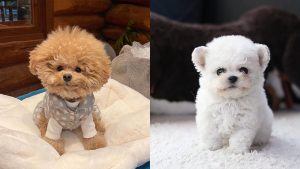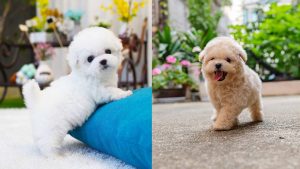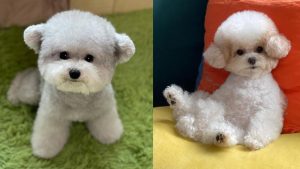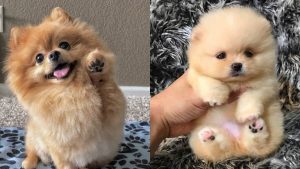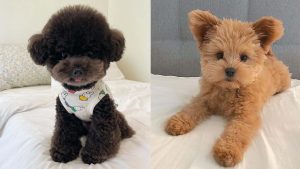The Australian Labradoodle is a stocky-looking dog that comes in a huge number of colors. They have often been likened to a living plush toy! Many feel they make the perfect family dog as they are highly trainable and intelligent.
The Australian Labradoodle is also considered to be a hypoallergenic dog, as shedding is low. Unlike breeds such as the Rottweiler, an Australian Labradoodle is ready to be friends with anyone it meets! What more could you want from man’s best friend (and everyone else’s)?
What is an Australian Labradoodle?

An Australian Labradoodle is a hybrid. As the name suggests, Bred from the Poodle and the Labrador Retriever, and the American and English Cocker Spaniel, Irish Water Spaniel, and Curly Coat Retriever.
They date back to the late 1980s, where they were bred initially as dogs for the visually impaired that also suffered from pet allergies. A man named Wally Conron received a request from a blind woman desperate for a hypoallergenic service dog.
She had not been able to get one yet, due to the extreme allergies of her husband. Wally Conron was a member of the Royal Guide Dog Association of Australia and, after that, became determined to produce a hypoallergenic guide dog.
The first Labradoodles were soon bred from a Standard Poodle and a Labrador Retriever. One out of the three puppies that were born proved hypoallergenic. After this success, the Labradoodle breed was advanced and tweaked to produce a consistent hypoallergenic coat in every puppy.
To achieve this, Irish Water Spaniels, American and English Cocker Spaniels, and Curly Coat Retrievers were added into the breeding lines. This new hybrid became the Australian Labradoodle.
Happily, they come in three main sizes: Standard, Medium, and Miniature/Toy. Adorable!
What does an Australian Labradoodle Look Like?
As this dog is a crossbreed or a hybrid, there are no ‘breed standards’ for the appearance of an Australian Labradoodle. However, there are some attributes you can expect to see.
Generally, this dog will have a squarish and cuddly, or stocky, frame like the Labrador Retriever. The coat tends to be cuddly and lumpy in appearance and has a kind of fleece consistency.
Whereas Labradoodles can have three possible coats (hair, fleece, or wool), the Australian version will only have fleece coats. These coats can be either curly or straight!

There is a variety of possible nose and eye colors. Noses are brownish pink, pink, or black, in different hues, depending on the color of the coat. Eyes can be found in a range of shades, from hazel to green to rich dark amber.
Coats likewise come in a massive variety of colors, from darkest black or chocolate brown to apricot and chalk white. Patterns, markings, and color mixtures are also common.
Like the parent breeds of the Australian Labradoodle, they are considered to be one of the most intelligent dogs in the world. Described as ‘stocky but graceful,’ they have a love of water and excellent swimming ability. Also known to be sociable, an Australian Labradoodle would be a good addition to a home with existing pets.
Australian Labradoodle Temperament

This is a friendly and well-mannered dog, affectionate and devoted to the families they live with. Australian Labradoodles are thought to be the perfect mixture of the best qualities in a Poodle, Labrador, and Spaniel!
They are clever and agile and have even been used as therapy and guide dogs. Once trained, they are obedient, loyal, and friendly.
Are Australian Labradoodles Good Family Dogs?
In a word, yes! Like the Cocker Spaniel, Poodle, and Labrador, they are energetic, playful, and social. Expect to hear endless amounts of joyful laughter from your children as they interact with this witty bundle of fun!
Just make sure to supervise your children with the miniature variety of this dog, as well as with puppies. Before they have developed properly, an Australian Labradoodle pup could get injured during roughhousing.
How Big do Australian Labradoodles Get?
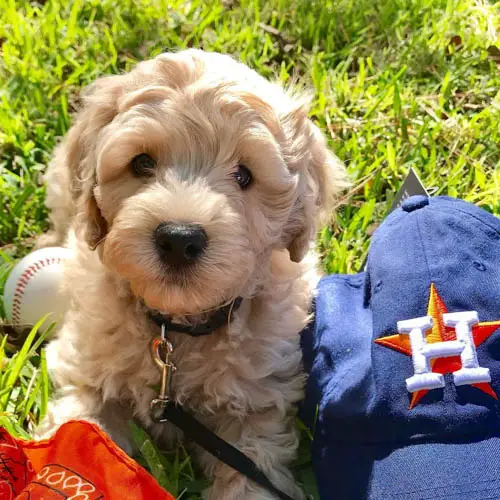
This hybrid dog breed comes in three main sizes, with males on average growing larger than females. The names for these sizes are the same as with the Poodle: Standard, Medium, and Miniature/Toy.
- The standard Australian Labradoodle will grow around 21-24 inches in height.
- Medium types will be in the range of 17-20 inches tall.
- Miniature/Toy Australian Labradoodles measure in at just a tiny 14-16 inches! Aww!
How Much do Australian Labradoodles Weigh?
They may look heavy but is it all just fleecy fur?!
- Standard Australian Labradoodles will usually weigh anywhere from 45-77 pounds.
- Medium-sized dogs will weigh in at the lowest 30 and highest 45 pounds.
- A full-sized Miniature or ‘Toy’ will reach just a dinky 15-30 pounds!
Do Australian Labradoodles Shed?
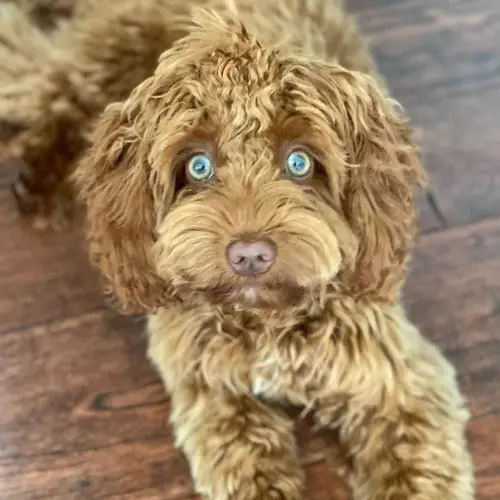
This is always a top concern among potential dog owners. Perhaps they have first-hand experience of the horrors of a seasonal shed-a ton with a previous pet. Rest assured, the Australian Labradoodle is listed as a low-shedding canine.
Yay! This is because their coats tend to take after their Poodle parents rather than the Labrador retriever. They have been noticed for being less on the smelly side, too.
Although they shed less than most, their coats still need proper maintenance. If your dog lives most of the time indoors, then bi-weekly brushing sessions should be enough to keep tangles and matts at bay.
For the more outdoorsy Australian Labradoodle, brushing and bathing should be a much more regular occurrence.
Regular haircuts will make it much easier for your dog to maintain a healthy and tidy coat. If you feel you can handle it, it’s possible to buy decent pet clippers online and learn how to trim your dog’s coat at home.
There is a wide range of helpful how-to videos available on sites like YouTube. If you need professional help, at least at first, it’s best to go to a pet groomer every three months or so.
Are Australian Labradoodles Hypoallergenic?

Yes, they barely shed at all! Their coats contain very low amounts of canine dander, as Australian Labradoodles inherit their coats from their Poodle parents. They are present on the hypoallergenic dog list.
This list is relative, and those with very strong pet allergies should keep in mind that reactions could still occur. No dog is allergy-proof as they will always shed some hair, just as humans do.
Allergies to dander may still be triggered, as dander levels on an Australian Labradoodle are low but not non-existent.
Dander is a collection of skin oils and dead skin, invisible to the naked eye. Where there is animal skin, there is dander, but this can be kept to a minimum with the regular bathing of the animal.
How Often Should an Australian Labradoodle be Bathed?
A mostly indoor dog that is regularly brushed shouldn’t need more than the occasional bath. A good guideline is once every season. This can be done more often if you have a sensitivity to dog hair and dander but isn’t strictly necessary for your pet’s health.
Do Australian Labradoodles Bark a Lot?
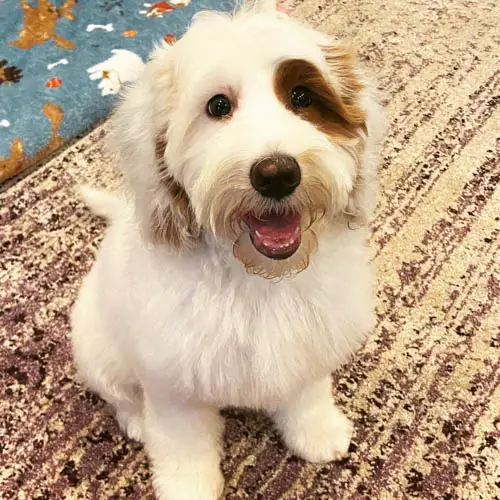
Because they are bred to be compassionate and gentle dogs, they are not known for unnecessary barking.
As Australian Labradoodles are intelligent, they can sometimes bark out of boredom if they aren’t given enough mental stimulation.
If you take time to properly train your dog from the start, excessive barking shouldn’t ever become an issue.
Are Australian Labradoodles Easy to Train?
Training an Australian Labradoodle is a… well, DODDLE! They are such bright dogs that picking up obedience training takes no time at all. For this reason, many owners can teach their Australian Labradoodle to do advanced tricks and tasks!
It is important to establish yourself as the alpha, or ‘pack leader,’ with this dog from the outset. As Australian Labradoodles are so intelligent, if you aren’t a clear leader, then they may soon outsmart you and wreak havoc in your home.
Be calm and firm but positive, rewarding correct behavior with praise and treats. Training takes patience and consistency, even with the cleverest of canines, but in the end, you will have a wonderfully well-mannered dog to show for your efforts! Don’t give up!
Australian Labradoodle Behavioural Problems

Possessiveness
This hybrid dog has possessiveness as an attribute. This is a plus when it comes to your protection. On the flip side, if your dog hasn’t been socialized, it may become aggressive towards new dogs and strangers.
It may also be territorial with its possessions (such as its bed and toys), and if not given access to these, then bad behavior will result. This possessive quality can be put in its proper place with persistent training at puppyhood. Perfect!
Frustration
An Australian Labradoodle will become frustrated if it isn’t given enough mental and physical stimulation in its life. If a dog is left alone all day in an unstimulating environment, it will soon become badly behaved.
For example, you should never leave your dog chained up all day alone in a yard. The Australian Labradoodle needs company, exercise, and mental challenges, or it will respond with whining or growling. Frustration can culminate in aggression.
Chaining up or locking in a kennel will cause frustration and anger to build through the day, and your dog may even attack once it is let free.
Boredom is bad for this intelligent creature and can result in barking and aggression. You would probably complain too if you’d been left in isolation all day with nothing to pass the time!
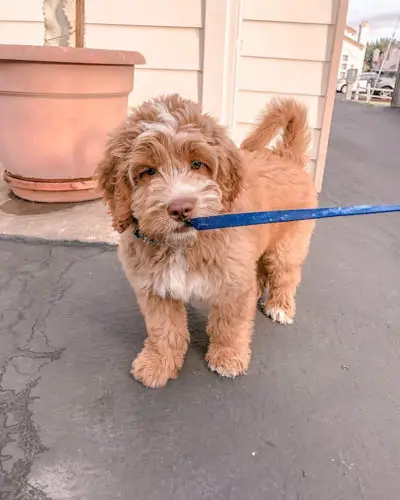
Aggression
Australian Labradoodles are actually known to be one of the least aggressive types of dog. If yours has suddenly become aggressive, there will be a good reason behind it. Injury or illness, fear, or lack of training can all be contributing factors.
Physical pain in your dog could be caused by sprained or broken bones, arthritis, muscular complaints, or even tumors. Pain will show itself with sudden aggressiveness, with no obvious explanation. In these cases, you must take your dog to the vet as soon as you are able.
Fear is another source of aggression. If your dog senses a dangerous situation, it will respond in self-defense. Do not allow anyone to play roughly with the dog; it may perceive this as an attack and fight back.
Lack of proper training and socialization will cause your Australian Labradoodle to translate new things like threats and act out accordingly.
To correct unwanted behavior, the first step is discerning the reason behind it. You owe it to your dog and your family to fix these issues, even if that means spending a little extra money on a professional training course. It’s worth it in the long run!
How Much Does an Australian Labradoodle Cost?

Oof. A lot. An adorable Australian Labradoodle puppy will set you back a cool $3,000! Why are they so expensive, you ask? Firstly, the ‘breed’ is both rare and in high demand. Authentic bloodlines aren’t easy to find.
Breeders must uphold strict standards when they are, meaning lots of expensive health tests on their breeding dogs. This all ensures the breed’s integrity is maintained, and dogs do not have random characteristics or genetic defects. You’d rather pay more and get the perfect puppy, right?!
Where to Buy or Adopt an Australian Labradoodle
The Australian Labradoodle Club of America has provided a helpful list of breeders in the United States and Canada. You can buy a puppy or adopt an ex-breeding dog, as you wish. Bear in mind; you may have to sign something promising not to use your dog for breeding.
Exercise Requirements for an Australian Labradoodle
Their energy levels are low to moderate, so half an hour of exercise each day should suffice. The Australian Labradoodle can do it all; it can join you on a stroll or a quick sprint. On family days out hiking, hunting trips, or days at the beach swimming and playing fetch! Mix things up, and you will have a happier dog for it.
Aside from the need for physical exertion, they need intellectual stimulation. Keep a range of toys indoors to keep your Australian Labradoodle fully occupied and out of mischief.
Common Health Issues in Australian Labradoodles
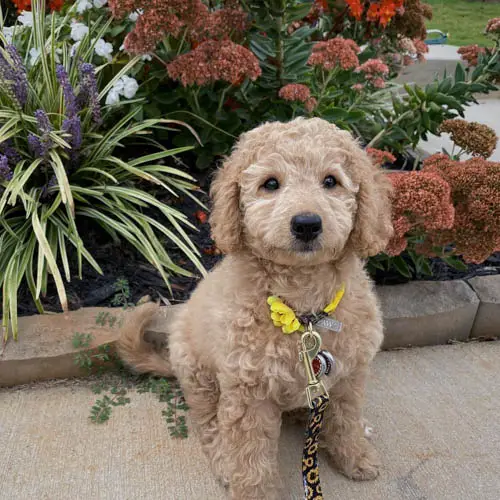
Like all breeds of dogs, the Australian Labradoodle has health problems.
Dysplasia
Poodles and Labrador retrievers tend to suffer from hip dysplasia as well as elbow dysplasia. Dysplasia is a skeletal condition where the ball and socket of a joint (such as the hip or elbow) fail to develop properly.
A normal ball and socket will fit together smoothly, but an ill-developed joint will rub and grind. Eventually, the joint will deteriorate and fail altogether. This condition is painful for the sufferer and will affect the quality of life of the dog drastically.
Specialists’ radiography checks can be conducted before breeding to minimize this health threat in the breeding lines. If your dog is a sufferer of this, it will become obvious in the puppy stage, with the rapid growth of bones and joints.
It can be prevented by slowing down the growth rate of your pup with a special diet. Keeping your dog’s weight in a healthy range will also help, as obesity takes a toll on the joints. Improper nutrition, too much or too little exercise can also heighten the chances of dysplasia.
Congenital Eye Diseases
Eye disorders can also be a common complaint. PRA (progressive retinal atrophy) occurs in cocker spaniels and miniature poodles and causes the sufferers to go blind. Australian Labradoodle breeders are encouraged to DNA-test their dogs for PRA before breeding takes place.
Diet Requirements of an Australian Labradoodle
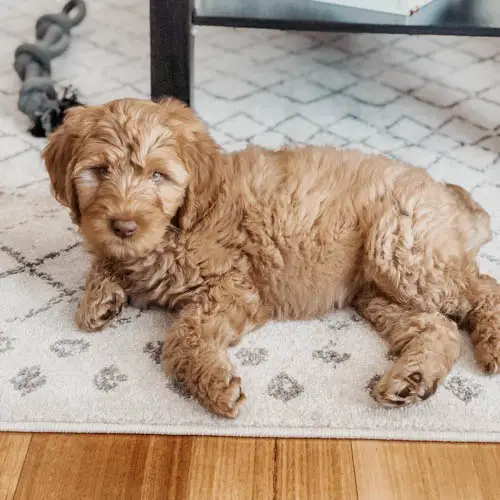
How Much Food to Give
A gorgeous little freshly weaned puppy should ideally eat four small meals a day. These should be evenly spaced if possible. Choose a dog food brand that isn’t too cheap but not so expensive that you can’t afford to stay with it.
Changing the food can result in digestive irritation, so this should be kept to a minimum. Australian Labradoodles can be picky eaters, and changing their food whenever they turn their noses up at it can result in entitled little doggies.
Although the breed isn’t known for being greedy, they can easily gain weight if fed too much. So how much food is too much food? Observe the shape of your new pup’s stomach before and after eating a meal. Measure the difference if necessary.
There should be a visible difference between a full tummy and an empty one. By the time of the next meal, your puppy should have a flattish stomach again. If it still looks full, then you will want to reduce the amount of food a little.
As your puppy grows, you should decrease the number of meals but increase the size. From the three-month mark, you should give three meals a day and two from six months onwards.
Which Diet to Choose
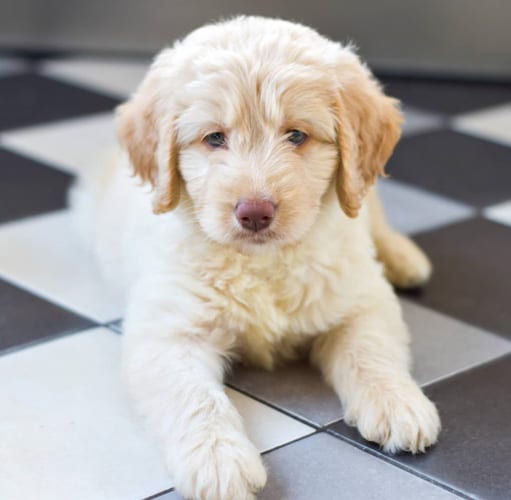
Many brands of kibble will be carefully formulated for your dog’s well-being. They should contain an appropriate balance of protein, fat, and carbohydrates, as well as minerals and vitamins.
Good news! Dry kibble and wet canned food must adhere to federal regulations! The regulations state that dog food should contain a balance of grains, cereals, protein, and vitamins. When you choose a dog food, find one with protein listed as the top ingredient rather than a protein by-product.
Australian Labradoodles are an energetic type of dog, and so must be fed carbohydrates to fuel them. The cereal and grain in the food should cover this need, but certain grains can cause allergic reactions compared with care.
Some canine enthusiasts rave about a raw food diet for their pets, or BBARF diets as they are known (Bones and Biologically Appropriate Raw Food). These consist of meats from muscles and organs, ground or whole bones, eggs, fruit, vegetables, and yogurt.
This diet can turn out very pricey, and some vets have expressed concern about possible harmful bacteria. According to devotees of the BBARF diet, it can improve your dog’s overall health, give it more energy and smaller bowel movements. Interesting.
Human beings take supplements, so why shouldn’t dogs? Canine supplements are effective in strengthening the immune system. They can relieve conditions like dysplasia, giving the body the extra help it needs to lubricate joints and repair soft tissue.
Improper nutrition can cause dysplasia, so it may be possible to prevent it altogether by taking supplements. Added nutrients can also serve to ease an aging Australian Labradoodle. Supplements give cell repair and growth a little added boost, helping any minor injuries to heal.
In Conclusion
Hopefully, after reading this article, there is nothing left to wonder about when it comes to the Australian Labradoodle. They are the best of the Standard Poodle, Labrador Retriever, and Cocker Spaniel.
A stocky looking yet graceful ‘living teddy bear’ that would love nothing more than to be your best friend. Friendly and affectionate, easy to train, and hypoallergenic! Great dogs for a family with children and eager to engage in practically any form of exercise, even swimming.
This dog will bring you endless laughter and delight with its wittiness and agility. They even come in three wonderful sizes. Admittedly, these loveable pups are expensive. But with what is arguably the perfect dog, the question is, can you afford NOT to get an Australian Labradoodle?!
